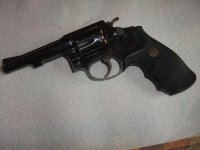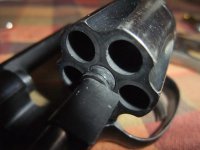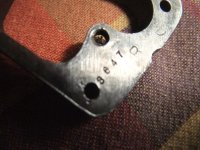jbinwa
Member
Let me start off by saying I've tried to do my homework on this one both on the forum search and on the Internet. Nothing definitive. I don't want to be the guy who asks without looking to see if existing information is available.
I even sent an email to S&W re. bore size on 33-1and no reply.
So since the S&W Forum is the place for all things S&W, I will pose the question here. What bullet diameter is proper for the 33-1?
I know earlier 38 S&W 38 cal. were .360 but was given to understand S&W was making J frame 38 Special concurrent with model 33-1s and those 38 Specials would have been a nominal .357 or .358. I was told it was likely the bore size in this final 38 S&W model would have been the .357 rather than making a .360 barrel for the very few 33-1 revolvers being sold after 1961. My 33-1 is a neat little gun with 4 in. barrel and has the 1.4 inch cylinder length which, again, I'm told is the length used by 38 Special in J frame.
I'm also aware that with unhardened lead bullets they will either bump up or squeeze down to go through the barrel depending on bullet dia. and barrel size. I'd rather be spot on than even safely squeeze or expand the wrong dia. through the barrel.
I'd like to know so I can reload for my 33-1 with correct size bullets and minimize leading and maximize accuracy.
Thanks for any information.
I even sent an email to S&W re. bore size on 33-1and no reply.
So since the S&W Forum is the place for all things S&W, I will pose the question here. What bullet diameter is proper for the 33-1?
I know earlier 38 S&W 38 cal. were .360 but was given to understand S&W was making J frame 38 Special concurrent with model 33-1s and those 38 Specials would have been a nominal .357 or .358. I was told it was likely the bore size in this final 38 S&W model would have been the .357 rather than making a .360 barrel for the very few 33-1 revolvers being sold after 1961. My 33-1 is a neat little gun with 4 in. barrel and has the 1.4 inch cylinder length which, again, I'm told is the length used by 38 Special in J frame.
I'm also aware that with unhardened lead bullets they will either bump up or squeeze down to go through the barrel depending on bullet dia. and barrel size. I'd rather be spot on than even safely squeeze or expand the wrong dia. through the barrel.
I'd like to know so I can reload for my 33-1 with correct size bullets and minimize leading and maximize accuracy.
Thanks for any information.













